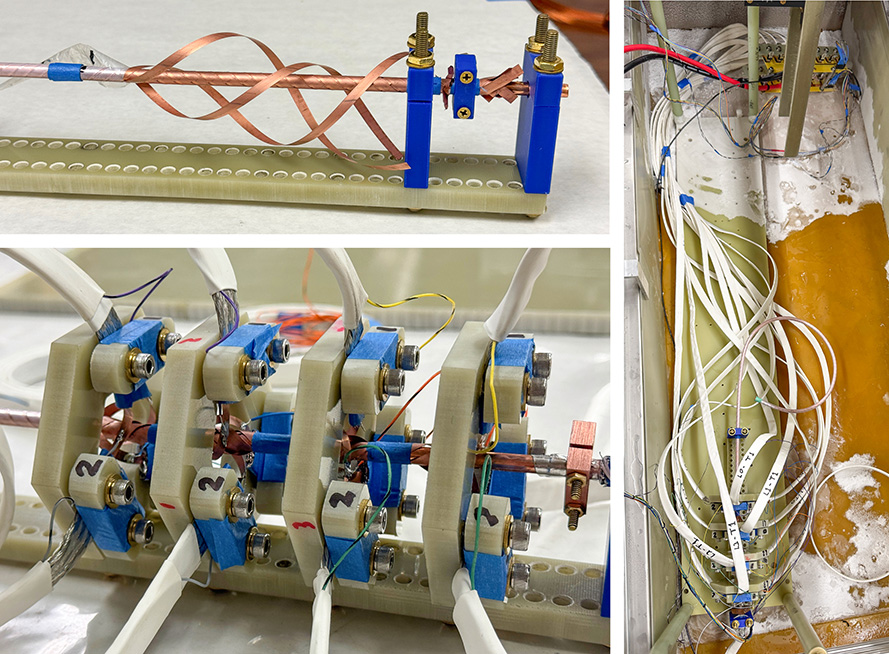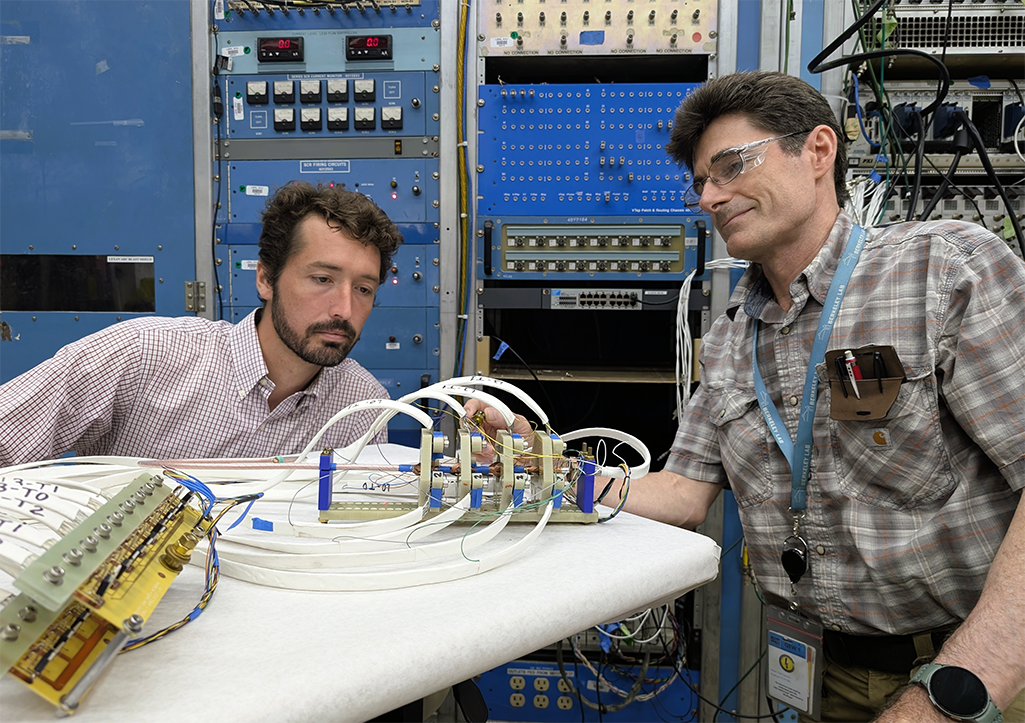Key Takeaways
- Researchers have developed a new method to measure inter-tape contact resistance in rare-earth barium copper oxide tapes used in high-temperature superconducting (HTS) cables.
- The research offers deeper insights into the current sharing among these cables, enhancing our understanding of inter-tape contact resistance.
- The work lays the foundation for designing improved HTS cables that promise more powerful and affordable superconducting magnets for applications in particle accelerators, medicine, fusion, energy storage, and many other fields.
A new technique to measure electrical resistance at the interface between different layers of rare-earth barium copper oxide (REBCO) tape in high-temperature superconducting (HTS) cables used in HTS magnets could help drive the development of more powerful and affordable devices.
The work, led by researchers from the Accelerator Technology & Applied Physics (ATAP) Division at the U.S. Department of Energy’s Lawrence Berkeley National Laboratory (Berkeley Lab), in collaboration with colleagues from the University of Colorado and Advanced Conductor Technologies LLC, could enable advances in particle accelerators and colliders and lead to breakthroughs in high-energy and nuclear physics, medical treatments and diagnoses, and fusion.
Measuring contact resistance between tapes
Although superconducting magnets wound with Conductor-on-Round-Core (CORC) cables made from REBCO tape promise magnetic fields of 20 tesla or more, the manufacturing processes used to produce the tape, along with magnet construction and operation, can introduce defects into individual tapes. These defects can cause the magnets to quench—a sudden and unpredictable loss of superconductivity due to localized heating, which can result in irreversible damage.
To prevent quenching, it is crucial to “understand, predict, and control the current-sharing behavior within these CORC cables,” explains Reed Teyber, a research scientist in ATAP’s Superconducting Magnet Program who led the development of the new technique with Chet Spencer, an engineering technician from Berkeley Lab’s Engineering Division.
“A key factor influencing cable performance is the resistance between the tapes inside these cables. Known as the inter-tape contact resistance, it affects how efficiently current is distributed around defects in REBCO tapes without generating heat that could cause runaway instability, leading to magnet quenching.”
Teyber says that accurately measuring inter-tape contact resistance and its variation along the cables “is essential for minimizing this resistance and safeguarding the cable.”
A new experimental design
While the traditional method for measuring inter-tape contact resistance uses Tape-In-Tape-Out (TITO) experiments, which involve selectively powering individual tapes within a cable and measuring the voltage drop across the interface between the tapes, the researchers found that their current percolation model showed that the high interconnectivity of tapes in CORC cables causes unexpectedly large currents to percolate through much of the cable, bypassing the contact interface.
According to Teyber, this leads to “an underestimation of the inter-tape contact resistance, as well as an inability to determine spatially varying values throughout the cable.”

(Top left) Unfurling the CORC outer layer. (Bottom left) The TITO termination, showing braided cable and a voltage tap connecting to each of 12 supported tapes. (Right) The TITO experiments, showing the cryo switch network (top) and the cable bent to a 76 mm radius.
To address this limitation, the researchers first designed a new experimental setup based on the TITO approach. This system employs an array of voltage taps and automated high-current cryogenic switching to precisely control and measure the electrical current between specific tapes within the cable. By systematically switching which tapes are connected, they were able to measure the resistances between each pair of tapes—something that current methods cannot do.
They then created a rapid simulation tool that models how current flows through a 90-cm-long CORC cable wound with 12 REBCO tapes, each 4 mm wide, arranged in four layers with three tapes per layer. This tool helped them disaggregate the local current sharing behaviors and determine inter-tape resistances. After passing currents through different tapes, they measured the resulting voltages and collected data on the current redistribution among the tapes, as well as how the resistance varies with the three different cable geometries: straight, bent to a radius of 152 mm, and bent to a radius of 76 mm. They used the simulation to analyze the data, adjusting the resistance values in the model until they matched their experimental results.
“By simplifying the percolation model, such as using the length-independent tape voltages in these experiments, we were able to run many simulations quickly, which helped optimize the measurements and analyses,” says Teyber.

Measurement results for L2 T2 – L3 T0 with the cable bent to a 76 mm radius. Simulated voltage distributions (bottom right) here are with the optimization extracted parameters.
The researchers found that the average inter-tape resistance decreased by more than 50% when transitioning from a straight setup to a 152-mm radius bend, with further bending to 76 mm causing additional, but minimal, decreases.
“This indicates that the mechanical pressure from bending greatly enhances the electrical contact between tapes,” says Teyber. “We also found that the resistance varies along the cable; the outermost layer of tapes had a higher resistance, while the innermost layer, directly next to the copper core, was two to three times more resistive than other internal layers.”
The work introduces a new quantitative method for measuring and understanding inter-tape contact resistance more accurately. This approach could help reduce contact resistance between tapes, improve current sharing among tapes, and increase the safety and performance of HTS cables and magnets.
Teyber says they plan to simplify their method “to make it easier to test more cables, improve our analysis algorithms for real-time monitoring, and investigate how inter-tape resistance changes as tapes transition in and out of the superconducting state.”
“Developing fast, data-driven models that predict contact resistance and real-time current distribution within magnet cables is a crucial step toward large-scale use of high-temperature superconductors for science and industry,” says Soren Prestemon, ATAP deputy director of technology and head of the Superconducting Magnet Program.
The research presented here was supported by the U.S. Department of Energy’s Office of Science, Office of High Energy Physics, through the U.S. Magnet Development Program (managed by Berkeley Lab), with additional support from the U.S. Department of Energy’s Office of Science, Office of High Energy Physics and Office of Fusion Energy Sciences.
To learn more …
Reed Teyber, Chet L. Spencer, Jeremy D. Weiss, and Danko C. van der Laan. “Tape-in-tape-out (TITO): A new approach for in-situ contact resistance measurements in high temperature superconducting CORC® cables,” accepted manuscript online 8 July 2025, https://doi.org/10.1088/1361-6668/aded3b
For more information on ATAP News articles, contact caw@lbl.gov.
